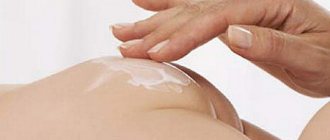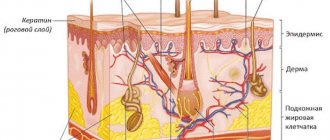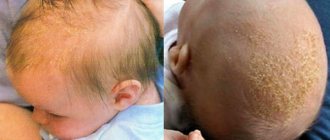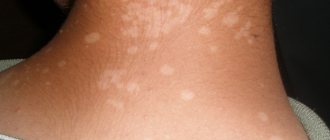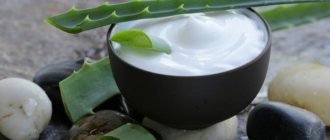Why the skin on the testicles peels - possible reasons
Peeling of the skin of the scrotum is most often caused by fungi. They are followed by various immune reactions, including allergies and eczema. Infectious and parasitic lesions occur infrequently.
The skin of the scrotum has its own characteristics, so dermatological diseases do not always manifest themselves on it in the classical form. Without laboratory methods, it is impossible to make an accurate diagnosis. Below we have provided general characteristics and photos of various types of scrotal peeling.
The chief physician of the clinic, dermatovenerologist Evgeniy Aleksandrovich Volokhov talks about diseases accompanied by peeling and itching of the skin of the scrotum
Athlete's inguinal
This term combines several types of fungal infections characteristic of moist folds of the skin, including the groin. A typical sign is scaly pink and red spots with blisters and crusts. The causative agents of peeling on the skin of the scrotum are most often Candida, Trichophyton mentagrophytes and rubrum, Epidermophyton floccosum.
Epidermophyton floccosum infection - https://prntscr.com/102nxxe.
Fungal infections of the skin of the scrotum include not only candidiasis, but also various types of lichen caused by dermatophytes. Peeling is often caused by trichophytosis, the causative agent of ringworm. At the same time, there are no characteristic circles on the skin with clearly defined edges. The photo shows peeling of the scrotum in the form of small mealy scales caused by trichophytosis.
Trichophytosis on the skin https://prntscr.com/102nz0z are classic signs.
Various manifestations of fungus on the scrotum: silvery, gray scales, plaques, wrinkled skin, dandruff – https://prntscr.com/102nzls, https://prntscr.com/102nzt2, https://prntscr.com/102o01p, https: //prntscr.com/102o5fw.
You can become infected with fungus in the gym, swimming pool, sauna, when using someone else's dirty laundry, or during sexual intercourse. Dermatophytes actively multiply in men suffering from metabolic disorders, excessive sweating, and poor personal hygiene. After the introduction of the pathogen, the skin of the scrotum turns red, itches, thickens, and becomes covered with scales and small crusts.
- A typical manifestation of candidiasis in the groin area and on the skin of the scrotum - https://prntscr.com/102o62b.
- Atypical candidiasis - https://prntscr.com/102o688.
Erythrasma
Erythrasma is a skin lesion caused by corynobacteria - microorganisms Corynebacterium minutissimum. Outwardly it looks like yellowish or brown spots with torn edges. Sometimes they are covered with small scales. Erythrasma occurs on sweaty areas of the skin. It mainly affects overweight men suffering from metabolic disorders.
Microorganisms Corynebacterium minutissimum under a microscope
Erythrasma on the skin of the scrotum - https://prntscr.com/102o717.
Rubrophytia
The causative agent of this infectious disease is dermatophyte fungi of the genus Trichophyton rubrum. Exacerbations occur in the warm season. Manifested by redness and slight peeling. The skin of the scrotum dries out and becomes covered with painful cracks. Areas of inflammation thicken. Peeling is directed from the center to the periphery. A roll of crusts is visible along the edges of the spots.
Inguinal rubrophytosis in a man – https://prntscr.com/102o7r8.
Pityriasis versicolor
The infection is caused by the Malassezia fungus. It appears as small dark brown or light yellow flaky spots without itching.
The causative agent of pityriasis versicolor is the Malassezia fungus.
- Pityriasis versicolor – https://prntscr.com/102o86e.
- Pityriasis versicolor in the perineum - https://prntscr.com/102o8cj.
Immune disorders
Skin defects of the scrotum in the form of peeling can occur due to the functioning of the immune system. As a rule, they are chronic, periodically exacerbating seasonally, but one-time manifestations are also possible.
Allergy
The cause of peeling of the scrotum may be an allergic reaction to laundry fabric, detergent, fabric softener or washing powder, lubricant, food, or medicine. Characterized by redness and burning. Peeling appears from scratching. When trying to self-treat with anti-allergy tablets and antiseptic lotions, the skin of the scrotum may become swollen and covered with blisters. The burning sensation intensifies many times over.
Allergic dermatitis of the scrotum - https://prntscr.com/102oae9.
Dermatovenerologist Lenkin Sergey Gennadievich examines a clinical case of the formation of allergic dermatitis of the skin of the scrotum in a young man
Ringworm Zhibera
This is a non-contagious disease. The exact reasons for its development are unknown, but dermatologists classify the pathology as infectious. There is a version that the cause may be herpes virus type 7.
Externally, lichen looks like pink scaly spots without itching. It begins with the formation of the main plaque. After 2-3 weeks more will appear, then their centers will turn yellowish and begin to peel off. The pathology worsens in the spring and summer after ARVI. Sometimes the inguinal lymph nodes become enlarged. The disease usually affects men between 20 and 40 years of age.
Deprive Zhiber - https://prntscr.com/102o9lz.
Atopic dermatitis
A type of allergic reaction is atopic dermatitis - neurodermatitis. This is a chronic, periodically worsening inflammation of the skin. Characterized by thickening of the skin of the scrotum, cracks, and unbearable itching. The disease occurs due to genetic predisposition under the influence of provoking factors: allergens, stress, viruses, vaccination, lack of hygiene.
Neurodermatitis (atopic dermatitis) of the scrotum – https://prntscr.com/102oayc.
Lichen planus
This is a chronic dermatosis that occurs against the background of disruption of metabolic and immune processes in the body. The trigger mechanism can be stress, therapy with bismuth and tetracycline, pathologies of the gastrointestinal tract, diabetes mellitus. Scrotal dermatosis manifests itself as a rash or slight peeling, reminiscent of psoriasis. The scales are large and difficult to separate from the skin. The appearance of spots is accompanied by severe itching, up to a neurotic disorder.
Lichen planus – https://prntscr.com/102od34.
Psoriasis
Usually psoriatic peeling is present on several parts of the body at once, but there are atypical isolated forms of pathology. Psoriasis on the scrotum is such an example. Peeling, redness, and periodic itching can bother you for years. Doctors take scrapings, do allergy tests and find nothing.
Isolated scrotal psoriasis – https://prntscr.com/102obm1.
Diabetes
Elevated sugar levels cause itching, dryness and flaking of the skin. Symptoms appear not only on the scrotum, but also on other parts of the body: elbows, knees, skin folds. Diabetic men often suffer from candidal balanoposthitis. The basis of treatment is to normalize blood sugar levels. To relieve external symptoms, anti-inflammatory ointments and antiseptics are prescribed.
Eczema
This is a non-contagious inflammatory skin lesion of an immune nature. The area of skin first turns red, then blisters and papules appear. After some time, they burst, forming weeping erosions. The sores dry out, become crusty, and begin to peel off.
Eczema on the skin of the scrotum - https://prntscr.com/102oc0q, https://prntscr.com/102ocdo.
Parasitic diseases
Parasites that affect the skin can also cause peeling of the scrotum. Their activity causes severe itching, and scales appear from scratching.
Pediculosis
Pediculosis (phthiriasis) is a lice infestation. Numerous bites cause itching, which provokes scratching, peeling, the appearance of bloody calluses and erosions.
Pediculosis – https://prntscr.com/102oh5t.
Scabies mite
Characterized by severe itching in the evenings and at night, the appearance of a red rash, scratching, and peeling. Streptococcus and staphylococcus are often associated, causing severe inflammation.
Scabies mite passages - https://prntscr.com/102ohoa.
Mechanism of scabies mite formation
STD
Itching and peeling of the scrotum can be caused by sexually transmitted infections: ureaplasma, gardnerella, genital herpes, trichomonas, latent syphilis.
Genital herpes
During the activation of a herpetic infection, the skin turns red and thickens, and a scattering of small itchy blisters appears. After 3-4 days they burst, the crusts dry out and begin to peel off. There may be a more aggressive version of the course: enlarged lymph nodes, pain in the scrotum, discomfort when urinating.
Herpetic rashes – https://prntscr.com/102ojes.
Dermatovenereologist Vyacheslav Vasilievich Makarchuk talks about the symptoms of genital herpes
Gardnerellas
Gardnerella is considered a female infection, since the microflora of the male urethra is unfavorable for it. However, with a decrease in immunity, the pathogen can take root and begin to reproduce. Additional symptoms: redness on the penis, sticky coating on the head, unpleasant odor.
Gardnerella peeling – https://prntscr.com/102okb2.
Circinar balanoposthitis
The disease manifests itself as grayish, slightly itchy, scaly spots with a white border. Accompanied by damage to the joints (Reiter's syndrome) and eyes. The main causative agent is chlamydia, Yersinia, Salmonella. To relieve symptoms, use 1% hydrocortisone cream. The main treatment is antibiotics based on test results.
Spots on the head with circinar balanoposthitis - https://prntscr.com/102ol7t.
We answer all questions:
Everything a man needs to know about balanoposthitis: types, symptoms and treatment methods.
Other reasons
Irritation of the skin of the scrotum and subsequent peeling is possible when wearing tight synthetic underwear, mechanical and chemical damage. The reason may be poor personal hygiene. Sweat and sebum are a favorable environment for the proliferation of fungi and bacteria.
Sexual infections
If the skin of the scrotum turns red and begins to peel, then it is possible that the man has contracted some serious disease. This happens most often as a result of unprotected sexual intercourse. Here is what kind of STD this symptom may indicate:
- Herpes.
- Trichomonas.
- Gonorrhea.
- Hidden syphilis.
As a rule, STDs are also accompanied by a burning sensation during urination, unpleasant discharge from the urethra, fever, rashes, general malaise, etc.
But the disease may not manifest itself in any way. Therefore, it is better to get tested and be examined by a venereologist.
Based on the results of the diagnosis, the specialist will prescribe an oral drug that acts directly on the pathogen. This could be “Gerpevir”, “Zovirax”, “Famvir”, “Acyclovir”, “Fluconazole”, “Nystatin”, “Diflucan”, “Flucostat”, “Ceftriaxone”, “Spectinomycin”, etc.
What to do if the skin on the scrotum is peeling
Which doctor should I contact: a dermatovenerologist, dermatologist, urologist. If autoimmune problems are detected, the patient will be referred to an allergist or immunologist, and if hormonal problems are detected, the patient will be referred to an endocrinologist.
Diagnostics
The doctor takes a scraping from the affected area, then examines it under a microscope and sends it for bacterial culture. It is necessary to insist on bacterial culture, since, according to doctors, laboratory assistants in most cases perform microscopy incompetently. The urologist of the Moscow KVD Lenkin S.G. openly states this:
What tests need to be taken and how to treat peeling on the scrotum, says urologist Lenkin Sergey Gennadievich
To identify allergies, they take blood for immunoglobulin E and circulating immune complexes and, based on the results, see which of them exceed the norm in quantity. An additional examination by an allergist is recommended to determine the types of allergens, including food ones.
If the test results show no fungus or allergies, the doctor takes a piece of scrotal skin for histological examination. Histology helps to understand what types of cells the defect consists of. In this way, psoriasis, eczema, cancer, and lichen are detected.
A reliable method for diagnosing a number of skin diseases is using a Wood's lamp. For example, erythrasma spots become coral under its light.
Erythrasma under Wood's lamp - https://prntscr.com/102prmt.
To exclude sexually transmitted infections, a smear is taken from the urethra, examined by PCR, and sent for bacterial culture. The doctor may also prescribe a general and biochemical blood test, a serological test to exclude syphilis.
Treatment
The treatment strategy for peeling on the scrotum depends on the diagnostic results. In the presence of sexually transmitted infections, the doctor prescribes appropriate antibiotics; for other pathologies, he selects specific therapy.
Allergy
For allergic dermatitis on the scrotum, calcium gluconate, sodium thiosulfate, anti-inflammatory ointments with corticosteroids such as Triderm, and enzyme preparations are prescribed intravenously. An important role in treatment is played by a hypoallergenic diet using intestinal sorbents, the most effective and safe of which is Enteros Gel. With proper treatment, allergic peeling of the scrotum goes away within 7-8 days.
Triderm is a drug with antibacterial, antifungal and anti-inflammatory effects for external use. Price from 630 rubles
Psoriasis
For the treatment of scrotal psoriasis, it is not recommended to use ultraviolet radiation so as not to provoke cancer. Antipsoriatic ointment "Naftaderm" and hormonal ointment "Dermavit" are prescribed. Calcium gluconate and folic acid are prescribed internally.
Erythrasma
For erythrasma on the scrotum, antibacterial ointments, salicylic cream, and antibiotic tablets are used. Erythromycin ointment is effective against Corynobacter. Gentamicin and syntomycin ointments also work, but much weaker. You can combine oral antibiotics and treatment with sulfur-tar ointment.
Antifungal syntomycin ointment. Price from 50 rubles
Fungus
For the treatment of scrotal mycoses, antifungal ointments and tablets are prescribed: Clotrimazole, Fluconazole, Itraconazole, Nystatin. When an infection occurs, antibiotics are added.
Eczema
To relieve symptoms, antiallergic drugs are prescribed: Loratadine, Tavegil. For external treatments, corticosteroid ointments are used: Betamethasone, Prednisolone, Sinaflan, Trimestin. It is important to follow a hypoallergenic diet and take sorbents.
Loratadine helps relieve itching, burning, skin rashes and other allergy symptoms. Price from 70 rubles
Ringworm Zhibera
Zhiber's lichen may not be treated. It is enough not to rub or scratch the stains, provide good ventilation, and adhere to a hypoallergenic diet. In some cases, treatment of the scrotum with zinc oxide and the application of corticosteroid ointments are prescribed. Antiviral drugs based on acyclovir and erythromycin significantly accelerate recovery. After about 6-8 weeks, the spots will gradually fade and disappear. If an infection occurs, folliculitis and pyoderma may develop.
Lichen planus
During the first week of treatment, peeling should not be wetted. The main emphasis is on corticosteroid ointments: Celestoderm, Elokom, Advantan. Absorbable preparations based on ichthyol, sulfur, tar, naphthalan, and salicylic acid are also used. Taking vitamins A, D, E, and group B has a positive effect. Twice a day you can lubricate the affected areas of the scrotum with zinc ointment.
Advantan suppresses inflammatory and allergic skin reactions. Price from 700 rubles
Pityriasis versicolor
To treat pityriasis versicolor, treatment of the affected areas with boric alcohol, application of sulfur-salicylic ointment, and washing of the scrotum with sulsen-based soap are prescribed. In severe cases, Diflucan is administered intravenously.
Scabies mite
Prescribed drugs: sulfur ointment, Spregal, ivermectin, Benzyl benzoate ointment. To reduce the intensity of itching, antihistamines and anti-inflammatory ointments are used. When an infection occurs, antibiotic ointments are prescribed.
Sulfur ointment relieves inflammation, heals, disinfects and heals the skin. Price from 40 rubles
Pediculosis
Preparations for lice: Medifox emulsion, Nittifor solution, Pedillin shampoo, Vitar soap. When fighting parasites, it is important to maintain hygiene: wash and thoroughly iron bed linen and clothes, treat pieces of furniture used by the patient.
Herpes
For herpes, antiviral drugs are prescribed: Acyclovir, Valvir. For mild cases, external treatments are sufficient; for severe cases, a weekly course of tablets is prescribed.
Antiviral drug "Acyclovir". Price of tablets from 60 rubles, ointments from 30 rubles
An example of treatment from the site https://03online.com/news/shelushenie_moshonki/2016-5-11-163927:
Alternative:
Atopic dermatitis
The pathology is not completely cured, but skin manifestations can be combated. The affected areas are lubricated with glucocorticosteroid ointments based on betamethasone, alklometasone, flumethasone. Safer and more modern drugs are topical calcineurin inhibitors, including pimecrolimus and tacrolimus.
15 minutes before the medicinal ointment, moisturizers - emollients - are applied to the affected area. The composition contains hyaluronic acid, aloe gel, lanolin, glycerin.
When treating atopic dermatitis, it is important to follow a diet. It is necessary to exclude spicy, smoked foods, citrus fruits, chocolate, whole milk, cocoa, eggs.
Treatment
Patients with dermatitis, prickly heat, and eczema are advised to eliminate the provoking factor. For all diseases, it is advised to follow the rules of hygiene, use soft cosmetics, and wear loose natural underwear.
Local treatment is widely used. For prickly heat and inguinal epidermophytosis, baths with string, celandine, chamomile, and potassium permanganate are useful. For pathologies accompanied by weeping, use mash and powder, and treat with antiseptics and oak bark infusion. Antifungal, antibacterial, hormonal and keratolytic ointments are applied according to indications.
Antihistamines are recommended to reduce itching. If there is irritability or sleep disturbances caused by unpleasant sensations in the affected area, mild sedatives with herbal components are added to the treatment regimen. For large foci of erythrasma, systemic medications with antibacterial action are prescribed. For some conditions, UV therapy is effective.
To treat the skin for scabies, special emulsions and aerosols are used; to prevent re-infection, the body, underwear and bed linen are treated according to a special scheme. For lice, pyrethroids, organophosphorus compounds, polydimethylsiloxanes and essential oils are used. Carry out appropriate epidemiological measures.
Prevention
Measures to prevent scrotal peeling:
- Maintain intimate hygiene: wash your genitals twice a day with baby or intimate soap, if necessary, lubricate with moisturizers, use anti-sweat powders.
- Protected sex. A condom will not save you from fungus, so after questionable contact you need to wash your pubis and scrotum with soap.
- Comfortable underwear made from natural materials. Synthetic briefs and tight trousers are a direct path to dermatitis of the scrotal skin.
- Compliance with hygiene rules in the bathhouse, sauna, swimming pool. You cannot use other people's towels, washcloths, sheets, or soap. Do not allow the scrotum to come into contact with surfaces.
If you are prone to allergies, you should not overuse citrus fruits, cocoa, and chocolate.
Troubleshooting
So, if the skin on the testicles is peeling, what should you do? If one of the above reasons is relevant, it is recommended to perform the following actions:
- Instead of synthetic underwear, start wearing cotton.
- Purchase hypoallergenic hygiene products.
- Take showers more often. At least wash your face in the morning and evening.
- Change your underwear once a day.
- Change professional activity.
Peeling that disappears after following these recommendations will indicate that the man is healthy.
However, if it continues to be present or even spreads to neighboring tissues, which is accompanied by an increase in other unpleasant symptoms, then it’s time to make an appointment with a urologist, dermatologist or venereologist.
Atopic dermatitis
This is the last of the most common reasons why peeling may appear on the scrotum. This is a non-contagious inflammatory skin lesion, manifested by dryness, irritation and itching. Occurs due to a decrease in the body's protective functions. In addition to peeling, dense plaques with dry bumps may appear on the scrotum.
It is recommended to avoid frequent washing of the genital area and use moisturizers for hygiene. To make the disease go away faster, you need to use the Skin-Cap series of products. There is a shampoo, an aerosol for treating the affected area and a cream. These are safe products that quickly eliminate itching and irritation.
You can also use creams called “Fucidin”, “Naftaderm” and “Radevit”. Zinc ointment and Tsindol suspension are also suitable.
But, again, only a specialist can prescribe adequate treatment. Therefore, when peeling appears on the scrotum, you should first go to the doctor for examination to identify the cause.
Structural features
As mentioned above, the scrotum creates and maintains the optimal temperature for spermatogenesis (34.5ºC). Stable maintenance of this temperature is achieved due to the sequential arrangement of several layers of the scrotal wall:
- Dermis (inner layer of skin). Its structure is no different from the skin of other parts of the body. It may have more pronounced pigmentation than the rest of the skin and is slightly more elastic.
- Fleshy shell. A connective tissue structure located just under the skin of the scrotum. Unlike most parts of the body, there are practically no fat cells in the musculature, it consists mainly of muscle fibers.
- Outer leaf of the spermatic fascia. This is a connective tissue formation that continues the superficial fascia of the abdomen.
- The levator testis muscle and its fascia. This is a rudiment of a formation found in some animals. The contraction of this muscle causes the testicle to be removed from the scrotum into the abdominal cavity. Thus, it is protected from injury. In humans, this muscle does not perform its function and is a rudiment.
- The inner layer of the spermatic fascia is a continuation of the fascia of the abdominal wall. It is fused with the surface layer of the tunica vaginalis of the testicle.
- The tunica vaginalis of the testicle is an analogue of the peritoneum and in embryogenesis is formed from its protrusion. It consists of two layers - the superficial (parietal), which fuses with the internal spermatic fascia, and the internal (visceral), directly adjacent to the testicle. Between them is a cavity filled with water.
Such a complex structure is not just a repetition and modification of the abdominal wall, it provides optimal conditions, gives the testicle a certain mobility, and protects it from injury. In addition, the scrotal tissue is rich in blood vessels and nerves, making it one of the most sensitive places on a man’s body.
Based on the anatomical structure, there are several general patterns of pathological processes in the scrotum. In particular, purulent inflammations are well contained by numerous fasciae; they usually take on a localized character.
Psoriasis
This unpleasant disease can occur for a variety of reasons. Genetic predisposition, problems with the endocrine system, impaired metabolism, disruptions in the immune system, emotional shock... there are many provoking factors.
The symptoms are specific. With genital psoriasis, the skin of the scrotum itches and peels, redness and a small rash appear, accompanied by itching, and discomfort occurs during urination and sexual intercourse.
To treat this disease, ointments such as “Antipsoriasis”, “Antipsor”, “Akrustal”, “Kartalin”, “Magnipsor”, “Cytopsor”, “Naftaderm”, “Daivobet”, “Berestin”, “Akrustal”, etc. are used d.
It is better to combine the use of local remedies with tablets. The doctor may prescribe drugs such as Milgamma, Befungin, Heptor licopid, Methotrexate, Metipred, Betamethasone and others.
